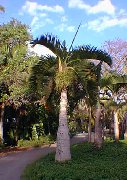Tips for Good Planting
by Jeff Wasielewski, former Assistant Curator of Tropical Fruit
The right plant in the right location. Bigger is better. A one dollar plant in a five dollar hole. You've heard the cliches, but what do they mean? And what really is the best way to plant a tree or shrub?
The right plant . . .
Begin with the healthiest tree available. New growth is a good sign that the plant is active. Take it out of its container and check its roots. Healthy roots, just as important as healthy leaves, are usually white and fibrous. They should be just beginning to grow to the edge of the soil in the pot. If they already fill the entire pot or wrap around the pot several times, the plant is root-bound and should be avoided. Roots that have begun to wrap may continue, and the resultant tree could be weakly anchored, slow-growing and prone to rot.

Bigger is better?
Not really. Many homeowners want instant gratification and plant the biggest tree they can find. This can be a mistake. A large tree either has been cut out of a nursery field (leaving many of its best roots back at the nursery) or has grown in a pot for a long time and is likely to be pot-bound. A young tree doesn't have these disadvantages. Once planted, its main support and storage roots will find their way right into your soil. You may be surprised to know that a year or two after planting, the small tree will be larger - and healthier - than the big tree.
. . . in the right location
If you follow this rule, you can save hundreds of dollars and years of heartache. Spend time thinking about what you want from a tree before you choose it, and you'll be rewarded by the perfect tree for many years. Get to know your garden. Which part gets full sun and which is shaded? Which area floods and which drains quickly? Consider the size and spread of the tree. Imagine the tree five, ten or twenty years from now. Will it be too close to your house or growing up into the power lines? Putting the right plant in the right location is never easy, but can be achieved by learning about the trees you want to plant and studying your garden.
A dollar plant, a five dollar hole
I don't disagree with the idea that the hole should be two to five times larger than the root ball of the plant, however, anyone who has ever taken shovel to earth in South Florida knows that digging even a one dollar hole is a challenge. It's more important to plant the tree at the proper level. All roots should be under ground, but none of the trunk can be under ground. Planting the tree at the same depth it was in the pot should suffice, but check to make sure everything lines up. Amending South Florida soil with peat or potting soil is unnecessary. If the tree is healthy, its roots will grow away from the planting hole, leaving the amended soil behind. Avoid fertilizing at the time of planting, waiting until the tree is well-established.

Watering
Once your tree is safely planted, it is crucial to water it thoroughly so that any large air pockets will be filled with soil. Water daily for the next few days, but after that, be careful not to water too often, which can be just as deadly as not watering it at all. After the first few days, the watering schedule should decrease at a steady rate until the tree is no longer dependent on your watering. This will force the roots to store water as well as search for water in the soil. Planting during the rainy season (July-August in South Florida) reduces your time watering and also gives your tree a good start by planting it when it is actively growing.
Mulch - the final step
A ring of mulch will keep grass away from the base of the trunk, which in turn will keep deadly weed-whackers and trimmers at bay. A two to five inch mulch layer discourages weeds and retains moisture. The mulch decomposes into nutrients and soil which will become available to the tree. Don't mulch directly next to the trunk; this could introduce pathogens or cause the trunk to rot.
Finally . . .
Once your new tree is safely planted, watered, and mulched, there's not much left to do but sit back and watch your garden grow. Several excellent books on South Florida landscape plants can be found at the Fairchild Garden Shop or in the Florida section of your library.
Copyright © 2005 Fairchild Tropical Botanic Garden, 10901 Old Cutler Road,
Coral Gables, FL 33156 USA Phone: (305) 667-1651 Fax: (305) 661-8953